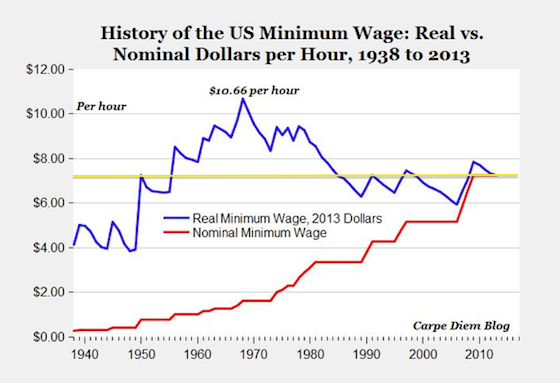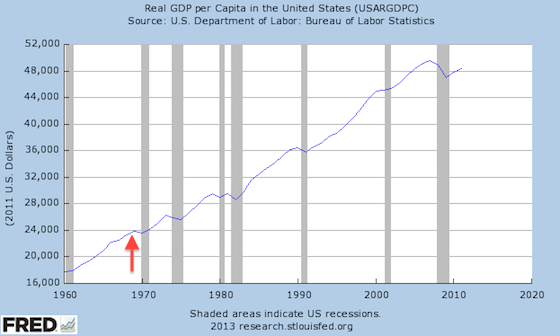Minimum-wage earners make nearly a third less than minimum-wage earners did 45 years ago.
But it’s “intellectually bankrupt” to point that out, according to The Wall Street Journal editorial page and a Richard Berman front group for low-wage employers.
The Employment Policies Institute’s Michael Saltsman (who disingenuously calls himself a “Defender of the Minimum Wage” on his Twitter bio) wrote an op-ed for the Journal a couple of weeks ago claiming it’s cherry-picking to point out what the minimum wage was in 1968, as Joe Biden did last month, and as I and others have many times.
Saltsman (emphasis mine):
The federal minimum wage was first set in 1938 at 25 cents an hour. Had it tracked the cost of living since, it would today be $4.07 an hour, based on Labor Department data and the Bureau of Labor Statistics’ inflation calculator. This is the only logically consistent “historic” value of the minimum wage, and it’s 44% less than the current amount of $7.25.
A few things here:
First, and most obviously, it’s false to say that the only “historic” value of something is its original value. Shares of Cisco, say, started trading at a split-adjusted 4 cents a share in 1990 (not adjusted for inflation). They hit $82 a share in 2000 and are at $25.50 today. It’s correct to say Cisco shares are down 69 percent since their peak in March 2000. It’s also correct to say they’re up 66,000 percent all time. Both are true. If you want to show how far Cisco has fallen since its peak, and how it’s been dead money for more than a decade, ou use the March 2000 number.
Second, 1968 was indeed the historic peak for the minimum wage, but as you can see in the chart below (I’ve added the yellow line to show today’s minimum wage), it was the crest of a three-decade era. From 1956 to 1985, the minimum wage was always higher than it is today. The $7.25 wage of today is actually a sliver below what it was before the Korean War started, in 1950:
Third, 1968 was a long, long time ago and the economy has grown enormously since then:
Fourth, that minimum-wage workers made $4.07 an hour in 1938—75 years ago, amidst the Great Depression—is interesting historically. Saltsman would have it be a baseline to show today’s low-paid workers how good they have it. Heck, why not go back to Triangle Shirtwaist wages while we’re at it?
Most people whose salaries aren’t funded by lobbies have this odd notion that we should all live better as time passes and technology advances and the economy grows massively richer. One significant measure of a society is how much its poorest laborers earn.
In 1968 we saw fit to pay our poorest workers $3.50 more an hour than we do today, and that says quite a bit about where we’ve gone in the last nearly half century.
And it’s far from cherry-picking to point that out.
Ryan Chittum is a former Wall Street Journal reporter, and deputy editor of The Audit, CJR’s business section. If you see notable business journalism, give him a heads-up at rc2538@columbia.edu. Follow him on Twitter at @ryanchittum.


